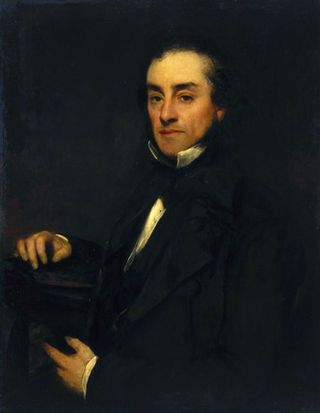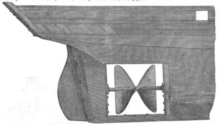
A propeller is a device with a rotating hub and radiating blades that are set at a pitch to form a helical spiral which, when rotated, exerts linear thrust upon a working fluid such as water or air. Propellers are used to pump fluid through a pipe or duct, or to create thrust to propel a boat through water or an aircraft through air. The blades are shaped so that their rotational motion through the fluid causes a pressure difference between the two surfaces of the blade by Bernoulli's principle which exerts force on the fluid. Most marine propellers are screw propellers with helical blades rotating on a propeller shaft with an approximately horizontal axis.

SS Great Britain is a museum ship and former passenger steamship that was advanced for her time. She was the largest passenger ship in the world from 1845 to 1854. She was designed by Isambard Kingdom Brunel (1806–1859), for the Great Western Steamship Company's transatlantic service between Bristol and New York City. While other ships had been built of iron or equipped with a screw propeller, Great Britain was the first to combine these features in a large ocean-going ship. She was the first iron steamer to cross the Atlantic Ocean, which she did in 1845, in 14 days.

A steamship, often referred to as a steamer, is a type of steam-powered vessel, typically ocean-faring and seaworthy, that is propelled by one or more steam engines that typically move (turn) propellers or paddlewheels. The first steamships came into practical usage during the early 1800s; however, there were exceptions that came before. Steamships usually use the prefix designations of "PS" for paddle steamer or "SS" for screw steamer. As paddle steamers became less common, "SS" is assumed by many to stand for "steamship". Ships powered by internal combustion engines use a prefix such as "MV" for motor vessel, so it is not correct to use "SS" for most modern vessels.

A paddle steamer is a steamship or steamboat powered by a steam engine that drives paddle wheels to propel the craft through the water. In antiquity, paddle wheelers followed the development of poles, oars and sails, where the first uses were wheelers driven by animals or humans.

Steam frigates and the smaller steam corvettes, steam sloops, steam gunboats and steam schooners, were steam-powered warships that were not meant to stand in the line of battle. There were some exceptions like for example the French Napoléon class steam ship of the line was meant to stand in the line of battle, making it the world's first steam battleship. The first such ships were paddle steamers. Later on the invention of screw propulsion enabled construction of steam-powered versions of the traditional ships of the line, frigates, corvettes, sloops and gunboats.

Benjamin Franklin Isherwood was an engineering officer in the United States Navy during the early days of steam-powered warships. He served as a ship's engineer during the Mexican–American War, and after the war did experimental work with steam propulsion. Rising to the rank of rear admiral, as Engineer-in-Chief of the Navy during the Civil War, he helped to found the Navy's Bureau of Steam Engineering.

Marine propulsion is the mechanism or system used to generate thrust to move a watercraft through water. While paddles and sails are still used on some smaller boats, most modern ships are propelled by mechanical systems consisting of an electric motor or internal combustion engine driving a propeller, or less frequently, in pump-jets, an impeller. Marine engineering is the discipline concerned with the engineering design process of marine propulsion systems.

Neafie, Levy & Co., commonly known as Neafie & Levy, was a Philadelphia, Pennsylvania shipbuilding and engineering firm that existed from the middle of the 19th to the beginning of the 20th century. Described as America's "first specialist marine engineers", Neafie & Levy was probably the first company in the United States to combine the building of iron ships with the manufacture of steam engines to power them. The company was also the largest supplier of screw propellers to other North American shipbuilding firms in its early years, and at its peak in the early 1870s was Philadelphia's busiest and most heavily capitalized shipbuilder.

Sir Francis Pettit Smith was an English inventor and, along with John Ericsson, one of the inventors of the screw propeller. He was also the driving force behind the construction of the world's first screw-propelled steamship, SS Archimedes.

Demologos was the first warship to be propelled by a steam engine. She was a wooden floating battery built to defend New York Harbor from the Royal Navy during the War of 1812. The vessel was designed to a unique pattern by Robert Fulton, and was renamed Fulton after his death. Because of the prompt end of the war, Demologos never saw action, and no other ship like her was built.

A steam yacht is a class of luxury or commercial yacht with primary or secondary steam propulsion in addition to the sails usually carried by yachts.

SS Sirius was a wooden-hulled sidewheel steamship built in 1837 by Robert Menzies & Sons of Leith, Scotland for the London-Cork route operated by the Saint George Steam Packet Company. The next year, she opened transatlantic steam passenger service when she was chartered for two voyages by the British and American Steam Navigation Company. By arriving in New York a day ahead of the Great Western, she is usually listed as the first holder of the Blue Riband, although the term was not used until decades later.

A marine steam engine is a steam engine that is used to power a ship or boat. This article deals mainly with marine steam engines of the reciprocating type, which were in use from the inception of the steamboat in the early 19th century to their last years of large-scale manufacture during World War II. Reciprocating steam engines were progressively replaced in marine applications during the 20th century by steam turbines and marine diesel engines.
J. and G. Rennie was a British engineering company based in Millwall, London, England. They were involved in manufacture of marine engines, and some complete ships, as well as other diverse onshore engineering projects. An association with railway engines is usually attributed to G. and J. Rennie, which may suggest they used a second company to keep the books separate, and there was also George Rennie & Sons, which is associated with the development and patents of the steam disc engine. All three companies appear to have been in existence at the same time.

Henry Wimshurst (1804–1884) was a 19th-century British shipbuilder. Wimshurst was in business at Ratcliffe Cross Dock in east London. He is remembered primarily as the builder of Archimedes, the world's first propeller-driven steamship.

A screw steamer or screw steamship is an old term for a steamship or steamboat powered by a steam engine, using one or more propellers to propel it through the water. Such a ship was also known as an "iron screw steam ship".

HMS Phoenix was a 6-gun steam paddle vessel of the Royal Navy, built in a dry dock at Chatham in 1832. She was reclassified as a second-class paddle sloop before being rebuilt as a 10-gun screw sloop in 1844–45. She was fitted as an Arctic storeship in 1851 and sold for breaking in 1864.

The Chaplin's patent distilling apparatus with Steam pump for circulating water attached was an early design of an evaporator, a device for producing fresh water on board ship by distillation of seawater. An example of this apparatus has been recovered from the wreck of SS Xantho (1872), an auxiliary steamship used in Australia to transport passengers and trade goods before ultimately sinking in Port Gregory, Western Australia in 1872. It is purported that the Alexander Chaplin distiller from the Xantho wreck is the only known surviving example of a Chaplin distilling apparatus on board a vessel of this period.
William Patterson Shipbuilders was a major shipbuilder in Bristol, England during the 19th century and an innovator in ship construction, producing both the SS Great Western and SS Great Britain, fine lined yachts and a small number of warships.

Steam-powered vessels include steamboats and steamships. Smaller steamboats were developed first. They were replaced by larger steamships which were often ocean-going. Steamships required a change in propulsion technology from sail to paddlewheel to screw to steam turbines. The latter innovation changed the design of vessels to one that could move faster through the water. Engine propulsion changed to steam turbine in the early 20th century. In the latter part of the 20th century, these, in turn, were replaced by gas turbines.























